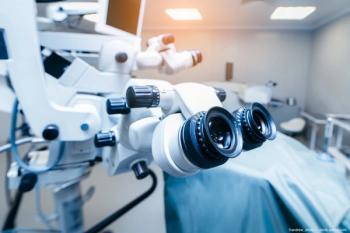
Vitreoretinal surgeon gives thumbs up to heads-up surgery
There are already several good reasons for ophthalmic surgeons to perform “heads-up” surgery. Further benefits to support its use are anticipated as the technology continues to evolve, said Claus Eckardt, MD, professor of ophthalmology, Klinikum Frankfurt Höchst, Frankfurt, Germany.
Chicago-There are already several good reasons for
Dr. Eckardt described his experience with a three-dimensional (3-D) visualization platform (TrueVision System)-which consists of a 3-D high-dynamic range surgical camera, specialized image capture and display software, and a 3-D passive LCD display monitor-during Retina Subspecialty Day at the annual meeting of
When he first connected the system to the surgical microscope, Dr. Eckardt said he was so impressed by the 3-D image on the monitor that he soon embarked on “heads-up” surgery-wearing 3-D glasses to view the surgical field on the monitor.
“After 3 weeks I found the microscope oculars were unnecessary and removed them completely,” Dr. Eckardt said. “In the past 7 months, I have used the heads-up technique to perform more than 500 phacoemulsification procedures and 400 vitrectomies without any restrictions for case selection and without any iatrogenic injuries related to its use, even in my learning curve.”
Dr. Eckardt said the benefits of the technology include improved fundus visualization, especially in situations where the level of illumination is critical. In addition, using digital image processing, additional brightness can be achieved thereby enabling reduction in light source intensity for better safety.
Greater comfort for the surgeon due to the ergonomically improved sitting position is another benefit of heads-up surgery, and the 3-D monitor image makes it an effective teaching tool.
Dr. Eckardt noted that both resolution and depth of field are somewhat lower than with conventional surgery using the microscope oculars. However, increasing the zoom level can compensate for these issues.
“I really have not had any problems because of the lower spatial resolution and depth of field,” he said. “I may be operating a bit slower using this technology, but perhaps the explanation is psychological. I am still so fascinated with the large image on the screen that I may be slowing down to enjoy the impression of greater surgical accuracy.”
Newsletter
Don’t miss out—get Ophthalmology Times updates on the latest clinical advancements and expert interviews, straight to your inbox.


















































.png)


